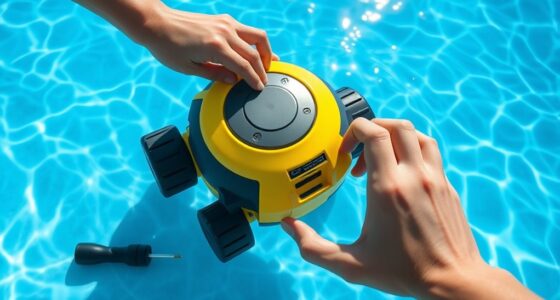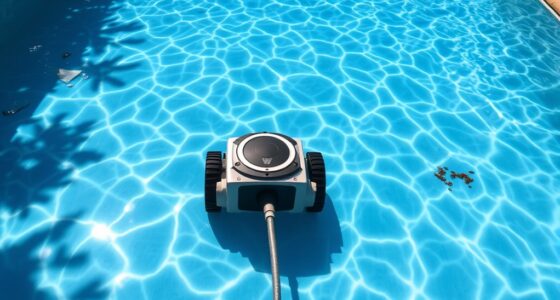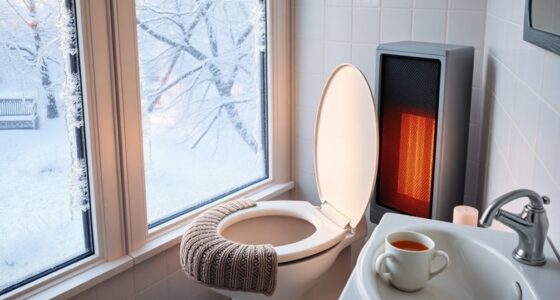Suction pool cleaners use your pool’s filtration system and are usually cheaper upfront, but they can require more maintenance and may not clean as thoroughly, especially in complex pools. Robotic cleaners operate independently, often providing better coverage, easier use, and superior debris removal, though they tend to cost more initially. If you want a more automated and efficient cleaning solution, robotic models may be better—continue exploring to find out which suits your pool best.
Key Takeaways
- Robotic cleaners operate independently with their own power, while suction cleaners rely on the pool’s filtration system for power.
- Robotic cleaners offer more thorough and consistent cleaning, especially in complex pool shapes and chemical conditions.
- Suction cleaners are generally more affordable upfront but may incur higher maintenance costs over time.
- Robotic cleaners require minimal manual setup and maintenance, providing greater ease of use and safety.
- Overall, robotic cleaners deliver superior debris removal and coverage compared to suction pool cleaners.
How Do Suction Pool Cleaners Work?
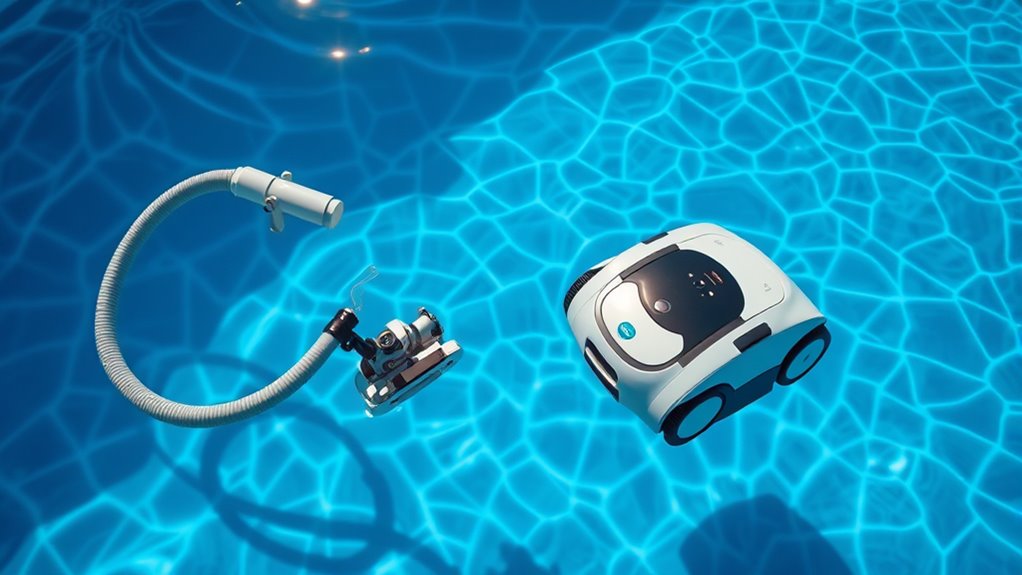
Suction pool cleaners work by connecting to your pool’s filtration system, using the existing pump to generate suction. As water flows through the cleaner, it pulls debris and dirt from the pool floor and walls. Maintaining proper pool water chemistry is essential, as balanced chemicals prevent algae buildup and keep debris loose, making cleaning easier. The cleaner’s suction power depends on your filtration system’s efficiency, so a well-maintained filter ensures maximum performance. These cleaners typically have hoses and a skim-vac head that moves around the pool, collecting dirt and small debris. Because they rely on your pool’s pump, they can be less effective in pools with weak filtration systems or imbalanced water chemistry, which can hinder proper debris removal. Additionally, filter maintenance plays a vital role in optimizing the overall cleaning efficiency of suction pool cleaners. Ensuring that the filtration system is regularly checked and serviced can significantly improve cleaning results and extend the lifespan of your cleaner. Proper pool water chemistry also helps prevent clogging and enhances debris collection efficiency, and understanding how vertical storage solutions can keep your pool area organized may help in maintaining easier access to cleaning equipment. Regularly inspecting your pool’s filter media can further enhance the effectiveness of your suction cleaner and reduce potential blockages.
How Do Robotic Pool Cleaners Function?
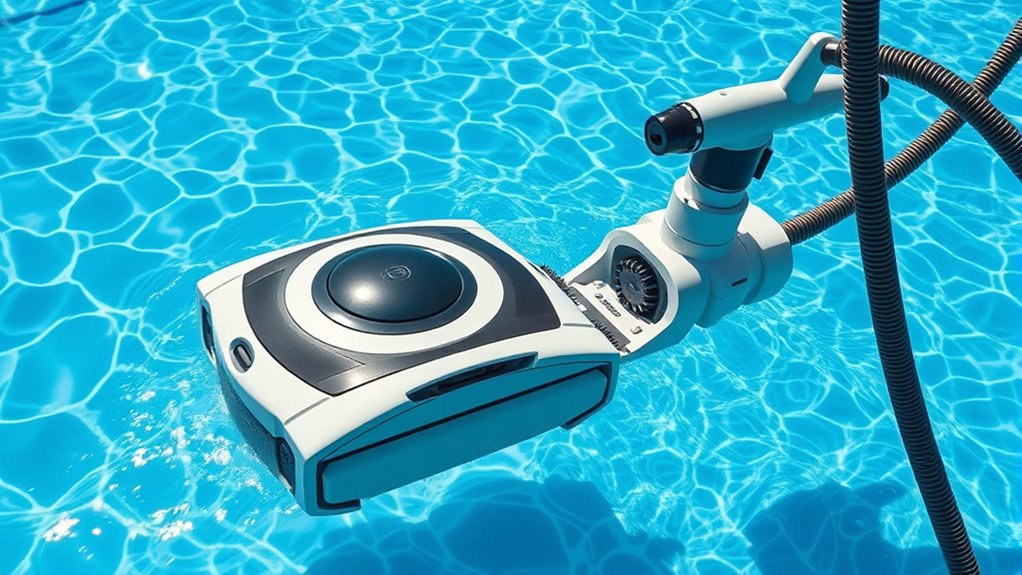
Robotic pool cleaners operate independently of your pool’s filtration system, using their own power source to navigate and clean the pool surfaces. They move across the pool floor and walls, thanks to built-in sensors and advanced navigation algorithms. During water chemistry adjustments, robotic cleaners adapt to different conditions, guaranteeing effective cleaning regardless of pH levels or chemical balance. They are also designed with energy efficiency in mind, reducing power consumption during operation. Unlike suction cleaners, they don’t rely on the pool’s pump, making them ideal for various pool installations. You simply program or turn them on, and they autonomously cover the entire pool area, scrubbing debris, algae, and dirt. Their intelligent movement ensures thorough cleaning, saving you time and effort. Additionally, many robotic cleaners feature diverse design options that enhance their functionality and aesthetic appeal, making them more effective and easier to operate. Their ability to adapt to different water chemistries and advanced navigation technology ensures consistent cleaning performance across varying conditions, emphasizing their reliability in maintaining a clean pool. Moreover, robotic cleaners often incorporate customizable cleaning modes, allowing users to tailor the cleaning process to specific pool needs. Overall, robotic cleaners are designed for efficiency, adapting seamlessly to your pool’s specific setup and water chemistry.
Cost Comparison Between the Two Types
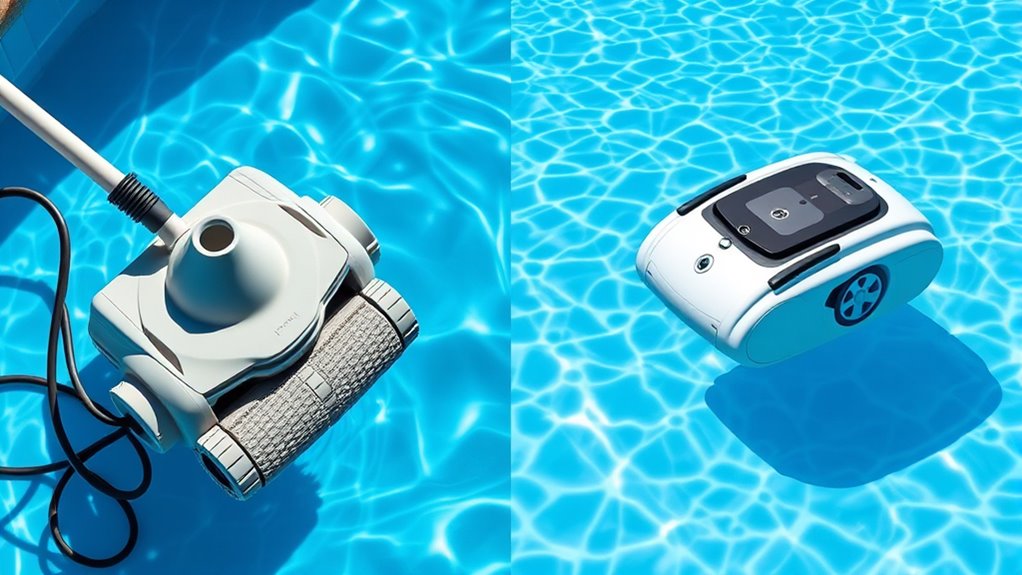
When comparing suction and robotic pool cleaners, you’ll notice differences in initial costs and ongoing expenses. Robotic cleaners often have higher upfront prices but can save money on maintenance, while suction models tend to be cheaper to buy but may require more frequent repairs. Understanding these costs helps you choose the best option for your budget and pool maintenance needs. Additionally, energy efficiency ratings are an important factor to consider, as they can influence long-term operational costs. Proper installation and maintenance can also enhance the longevity and performance of your chosen cleaner, ultimately providing better value and efficiency. Regular upkeep and selecting a model suited to your pool size can further optimize performance and reduce long-term costs. Considering the cost of replacement parts is also crucial, as some models require more frequent part replacements which can add to overall expenses. Being aware of the long-term durability of each cleaner can help prevent unexpected expenses and extend the lifespan of your investment.
Initial Purchase Cost
Although the initial purchase cost varies between suction pool cleaners and robotic pool cleaners, understanding these differences is essential for making an informed decision. Suction pool cleaners generally have a lower upfront cost, often due to simpler designs and basic pool material compatibility. They usually require a straightforward installation process, connecting directly to your skimmer or suction line, which keeps expenses minimal. Additionally, essential oils for pool maintenance can support optimal pool health and cleanliness, complementing the use of your chosen cleaner. While the upfront investment differs, considering factors like sound healing science and technological features helps you choose a cleaner that aligns with your Volkswagen Tuning budget and pool type.
Maintenance Expenses
While suction pool cleaners typically cost less upfront, their maintenance expenses can vary depending on usage and pool conditions. If your pool’s chemical balance isn’t maintained properly, it can cause buildup and wear on parts, increasing repair needs. Regularly checking filters and hoses is essential to prevent clogs and damage, which could lead to higher costs. Additionally, hydrocolloid material used in acne patches promotes healing by drawing out impurities, which is a beneficial feature for targeted skin treatment. Robotic pool cleaners often come with extensive warranty coverage, reducing repair expenses during the warranty period. In contrast, suction cleaners usually have fewer warranty benefits, so repairs might come out of pocket. Overall, robotic cleaners may have higher initial costs but tend to be more cost-effective over time due to lower maintenance and repair costs, especially if you keep your pool’s chemical balance steady. Additionally, understanding pool maintenance routines can help in managing stress related to maintenance routines and ensure long-term satisfaction with your pool care choices. Proper electrical safety practices also contribute to preventing accidents and costly repairs, emphasizing the importance of routine inspections and following manufacturer guidelines.
Ease of Use and Maintenance Requirements
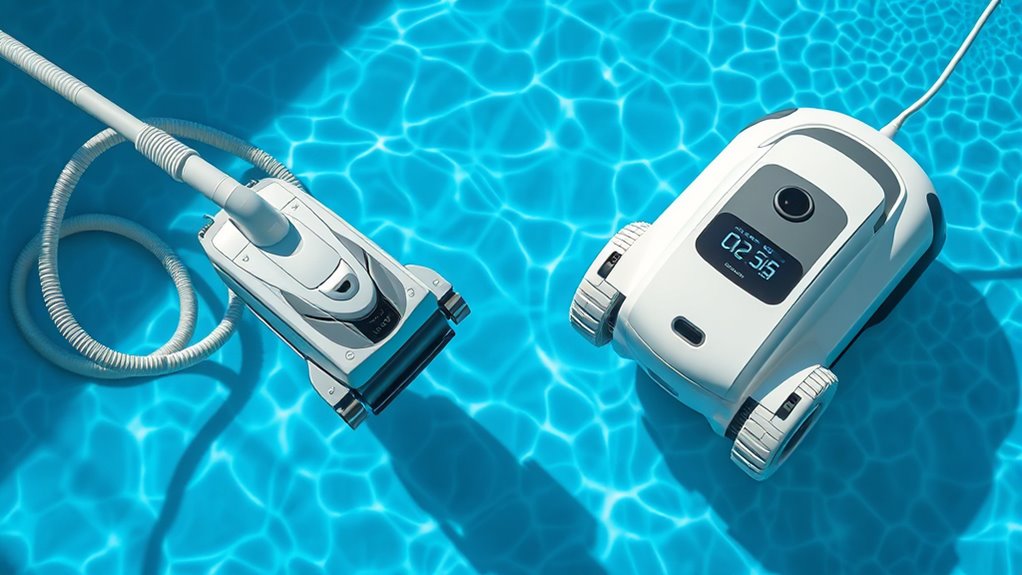
Robotic pool cleaners generally offer a more straightforward and hassle-free experience when it comes to ease of use and maintenance. You’ll find they require minimal setup and operate automatically, saving you time. Their design helps maintain pool aesthetics by keeping the water clear and inviting without much effort on your part. Maintenance involves simple tasks like cleaning filters and occasionally inspecting components, which are straightforward and quick. Robotic cleaners also enhance user safety, as they often have safety features to prevent accidents and operate smoothly without risks. In contrast, suction pool cleaners might need more manual intervention, such as adjusting hoses or clearing debris from skimmers. Overall, robotic models simplify your pool upkeep, making it easier to enjoy a clean, safe, and visually appealing pool environment. Additionally, robotic pool cleaners are often equipped with advanced technology, which further streamlines the cleaning process and ensures thorough coverage of your pool surfaces. For example, their navigation systems improve cleaning efficiency and reduce the time needed to maintain your pool. Moreover, integrating state-of-the-art features can optimize their performance and extend their lifespan, especially considering the Kia Tuning innovations that enhance vehicle performance. Incorporating innovative design elements can also contribute to better durability and functionality over time.
Cleaning Performance and Coverage
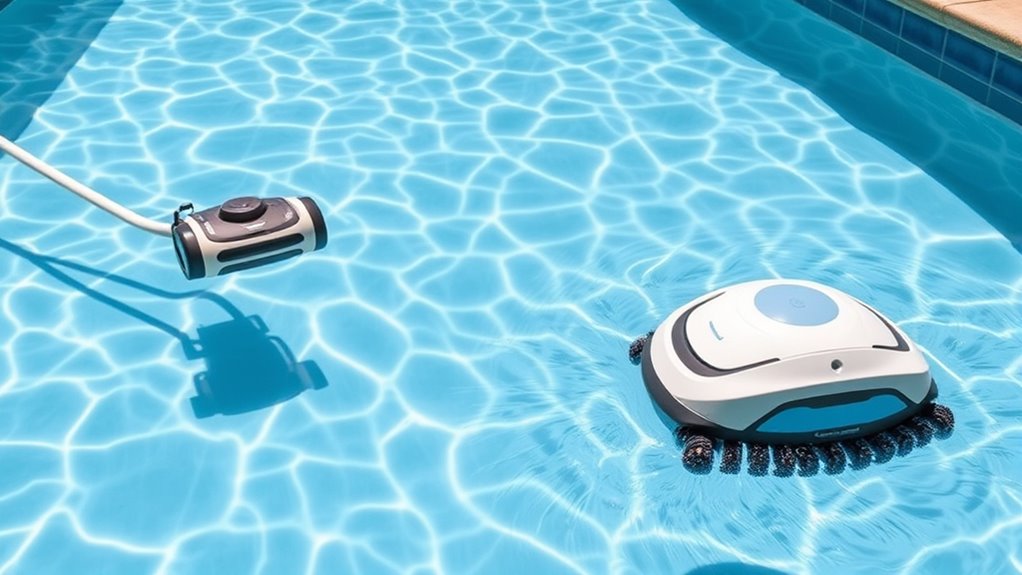
When it comes to cleaning performance, you’ll notice differences in efficiency and how well each cleaner covers your pool. Some models handle debris better, while others might miss spots or struggle with larger debris. Understanding these variations helps you choose a cleaner that matches your pool’s specific needs.
Cleaning Efficiency Variances
Suction pool cleaners and robotic pool cleaners differ substantially in their cleaning performance and coverage. Suction cleaners rely on your pool’s pump and filter types to pick up debris, making them effective for larger particles but less so for fine dirt or algae. Their cleaning efficiency depends on the filter type, which can limit or enhance debris removal. Robotic cleaners operate independently, often equipped with specialized filters designed to trap fine particles and debris, resulting in superior cleaning efficiency. They typically scan the pool thoroughly, covering surfaces more consistently. While suction models can struggle with pool chemicals that cause algae buildup, robotic cleaners adapt better to various conditions. Overall, robotic cleaners tend to deliver more consistent and thorough cleaning, especially in pools with complex shapes or chemical imbalances.
Coverage Area Differences
While both suction and robotic pool cleaners aim to cover the entire pool surface, their effectiveness varies greatly in terms of cleaning coverage. Suction cleaners often struggle with uneven pool shapes and may miss corners, especially in pools with complex layouts. Robotic cleaners typically offer more consistent coverage, adjusting their paths based on pool features. Factors like pool color and material influence performance; darker colors can hinder visual navigation, while rough surfaces may trap debris, reducing efficiency. Robotic models usually adapt better to different pool types, ensuring more thorough cleaning. Suction cleaners might require manual repositioning to cover all areas. Ultimately, coverage depends on the cleaner’s design, the pool’s shape, and material, with robotic cleaners generally providing superior coverage and cleaning performance.
- Pool shape complexity affects cleaner navigation
- Pool material impacts debris adherence and movement
- Darker pool colors can hinder robotic sensors
- Irregular pool corners challenge suction cleaners
- Surface texture influences debris trapping and cleaning efficiency
Debris Handling Capabilities
Robotic pool cleaners generally excel at handling debris thanks to their advanced sensors and precise navigation, ensuring more consistent cleaning performance across various pool surfaces. They can detect dirt, leaves, and small particles, adjusting their path to maximize debris pickup. This results in better water filtration, as more debris is captured before it settles or clogs filters. Unlike suction cleaners, robotic models often have dedicated debris compartments, reducing the burden on your pool’s pool chemicals and filtration system. Their ability to target and remove debris thoroughly helps maintain clearer water and reduces the need for chemical adjustments. Overall, robotic cleaners offer superior debris handling capabilities, making them more effective at keeping your pool clean and water quality high, with less manual intervention.
Energy Efficiency and Operating Costs
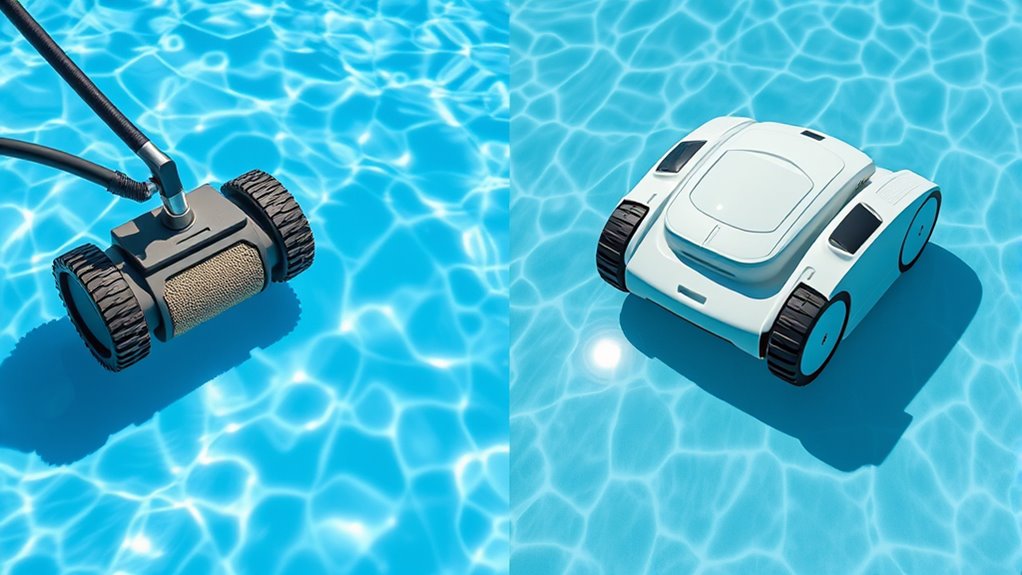
When comparing energy efficiency and operating costs, robotic pool cleaners typically consume less electricity than suction pool cleaners, making them a more economical choice over time. Their lower power consumption translates into significant energy savings, which reduces your long-term expenses. Robotic cleaners often have efficient motors and programmable schedules that optimize operation, further lowering energy use. Additionally, they usually operate independently of your pool’s filtration system, decreasing the strain on existing components. This results in less wear and tear and fewer maintenance costs. Overall, robotic cleaners’ focus on energy efficiency helps you save money on electricity bills and prolongs their lifespan. Consider these factors to choose a cleaner that offers both energy savings and cost-effective operation.
Suitability for Different Pool Sizes and Shapes
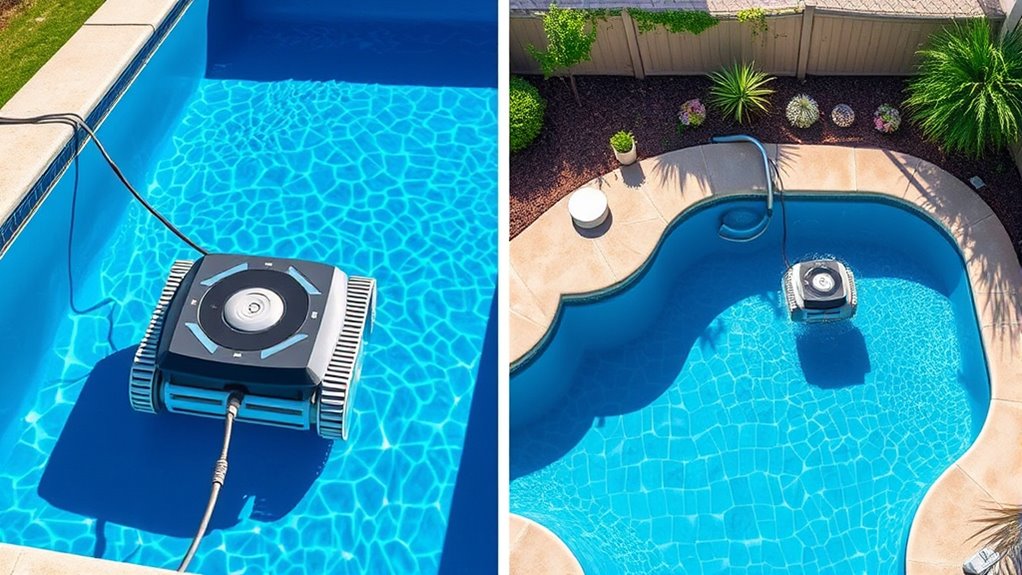
Choosing the right pool cleaner depends heavily on your pool’s size and shape. Suction pool cleaners work well for small to medium pools with simple shapes, like rectangular or oval designs, especially if your pool material is smooth, such as fiberglass or plaster. They can navigate straightforward layouts efficiently but may struggle with complex shapes or large areas. Robotic pool cleaners excel in handling diverse pool shapes, including irregular or curved designs, thanks to their programmable routes and sensors. They are suitable for various pool materials, like tile or vinyl, as they often have brushes designed to clean different surfaces thoroughly. For larger or uniquely shaped pools, robotic cleaners offer better coverage, while suction cleaners are more cost-effective for simpler configurations.
Additional Features and Technological Advancements
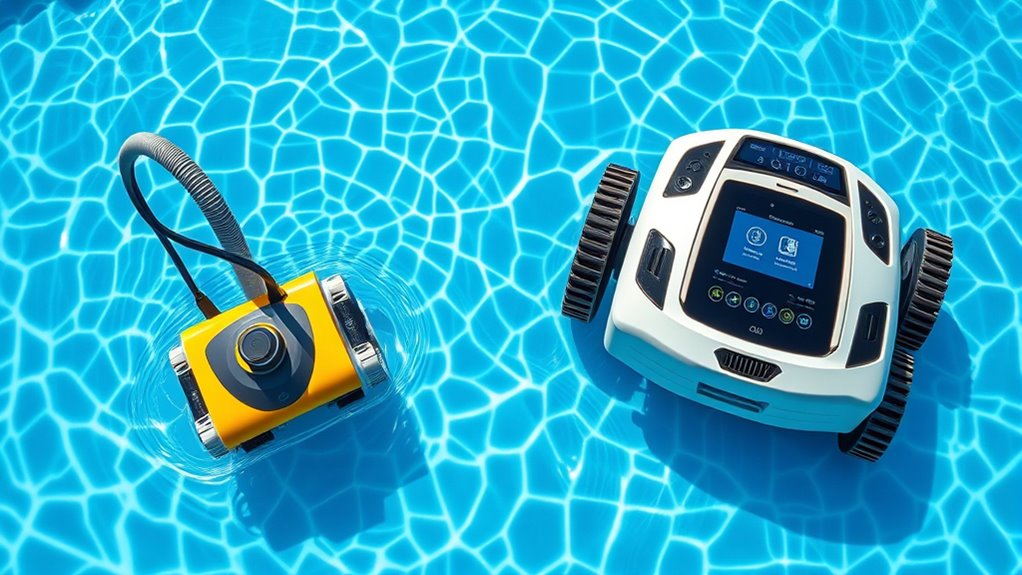
Modern pool cleaners are packed with advanced features that enhance their efficiency and ease of use. You’ll find smart navigation systems that allow the cleaner to map your pool and optimize cleaning paths, saving time and energy. App control lets you operate and monitor your cleaner remotely, giving you convenience at your fingertips. Many models now include sensors to detect obstacles and prevent collisions, improving safety and performance. Some cleaners feature programmable schedules, so your pool stays spotless without manual effort. Additionally, innovations like adjustable cleaning modes and real-time status updates make maintenance simpler and more efficient. These technological advancements guarantee your pool stays clean with minimal effort, making choosing the right cleaner a smarter investment.
Frequently Asked Questions
Which Pool Cleaner Is More Environmentally Friendly?
Think of choosing an eco-friendly pool cleaner as picking a gentle gardener. Robotic cleaners often have better energy efficiency, using less power to do their job, making them a wise choice for water conservation and reducing your environmental footprint. Suction cleaners may use more energy and water, like a gardener overwatering plants. So, for a greener pool maintenance, go robotic—it’s more sustainable and kinder to the planet.
Can Suction and Robotic Cleaners Be Used Together?
You can use suction and robotic cleaners together, but dual operation might lead to compatibility issues. Some models are designed to work seamlessly with others, while some may require specific setups or adapters. To avoid problems, check if your cleaners are compatible and follow manufacturer instructions. Using both can be effective for thorough cleaning, but guarantee they don’t interfere with each other’s operation for ideal results.
How Long Does Each Cleaner Typically Last?
You might wonder how long each cleaner lasts. Typically, suction pool cleaners need less maintenance and can last about 5-8 years if you keep up with regular maintenance. Robotic pool cleaners often last 4-7 years, but repair costs can be higher if parts break. Regular maintenance reduces breakdowns, helping both types run longer. So, expect a few years of reliable service with proper upkeep, but be prepared for occasional repairs.
Are There Safety Concerns With Either Cleaner?
They say safety first, and that holds true for pool cleaners too. With either option, you should consider electric safety and maintenance concerns. Suction pool cleaners connect to your skimmer or dedicated line, so guarantee proper grounding. Robotic cleaners are usually safer with their built-in electrical systems, but regular maintenance prevents electrical issues. Always follow manufacturer instructions to avoid hazards and keep your pool area safe and worry-free.
Which Cleaner Is Better for Algae Removal?
When choosing a cleaner for algae removal, you want one that offers high cleaning efficiency. Robotic pool cleaners excel here because they scrub surfaces thoroughly and cover the entire pool, breaking down algae more effectively. Suction pool cleaners can also help, but they may not be as thorough. For the best algae removal, a robotic cleaner is often the smarter choice due to its superior cleaning efficiency and ability to target problem areas.
Conclusion
Choosing between suction and robotic pool cleaners is like selecting the perfect dance partner—each has its rhythm and style. Suction cleaners are reliable and straightforward, while robotic ones bring high-tech finesse to your pool. Think of it as finding the right instrument in an orchestra; your decision shapes the harmony of maintenance. Whichever you pick, you’ll be orchestrating a sparkling, inviting pool that’s ready for your next splash.


